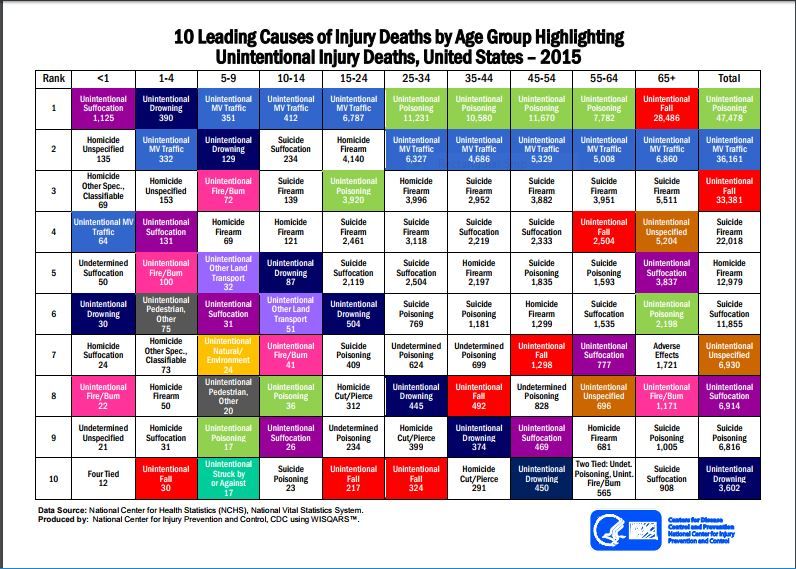Toxins or Trauma?
A look at unintentional causes of injury death in the United States and medication safety.
The most recent CDC data show that unintentional injury is the No. 4 cause of death in the United States.
And since 2011, the number of unintentional poisonings has surpassed unintentional motor vehicle traffic as the No. 1 cause of unintentional injury death.1 A growing number of these poisonings are likely related to the opioid epidemic, but there are still many non-opioid related poisonings.
The figure below illustrates the most recent CDC data of the 10 leading causes of unintentional injury deaths by age group.
Working at a level 1 trauma center, trauma patient care is discussed often among pharmacy learners, while toxicology is discussed less often. Working in poison control, we commonly manage unintentional medication-related overdoses.
Most of the time, it is a child who has found a bottle of medication and is discovered by parents. Some of these situations can be managed at home, depending on the medication.
At times, parents do not know how much medicine was taken, and children need to be monitored in the emergency department (ED).
A more worrisome example is a toddler who is found with a bottle of a grandparent’s verapamil 240mg modified-release tablets. Other times, it is the caller who has “double-dosed” their regular prescription.
Occasionally, taking that medicine could have ominous consequences, and these patients will need to be seen in an ED. These medicines include opioids, calcium channel blockers, or antipsychotics.
The 2015 American Association of Poison Control Centers (AAPCC) Annual Report shows that the top 4 substance categories with the greatest rate of exposure increase for more serious outcomes are sedative/hypnotics/antipsychotics, analgesics, antidepressants, and cardiovascular drugs.2 The rate of these exposures has continued to increase over the past 20 years, and it will likely continue to climb.
These data are compiled from the National Poison Data System, which is the data warehouse for US poison centers.
Overall, the top 5 most frequently encountered substances in human exposures are analgesics, household cleaning substances, cosmetics/personal care products, sedative/hypnotics/antipsychotics, and antidepressants.
Although we cannot regulate how people manage every aspect of their medicines in their homes, we can counsel them on the safe use and storage of medications.
The culture of medication use in the United States may give some people a false sense of security, so the thought of preventative measures is not apparent until after it happens. Unfortunately, I have managed many calls where people do not believe how bad the potential effects of overdosing on medications can be.
Here are the key points I try to share with anyone who calls the poison center or comes to the ED with an unintentional poisoning concern are:
- All prescription and OTC medicines, vitamins, and herbals are potentially dangerous
- Child-resistant does not mean that it is childproof.
- Keep all medicines out of sight and where children cannot reach them.
- Do not take medicines in front of children.
- Keep all medicines in their original container or in the pill calendar.
- Appropriately discard old medicines.
- Keep the number for poison control (1-800-222-1222) in multiple places.
Some of these points also pertain for non-medicinal substances, such as cleaners, detergents, and automotive products. More information on medication safety can be found at poisonprevention.org or by visiting the AAPCC website.
References
1. CDC. Ten leading causes of death and injury. cdc.gov/injury/wisqars/leadingcauses.html. Updated May 2, 2017. Accessed September 21, 2017.
2. Mowry JB, Spyker DA, Brooks DE, Zimmerman A, Schauben JL. 2015 annual report of the American Association of Poison Control Centers’ National Poison Data System (NPDS): 33rd annual Report. Clinical Toxicol. 2016;54(10):924-1109. doi: 10.1080/15563650.2016.1245421.

